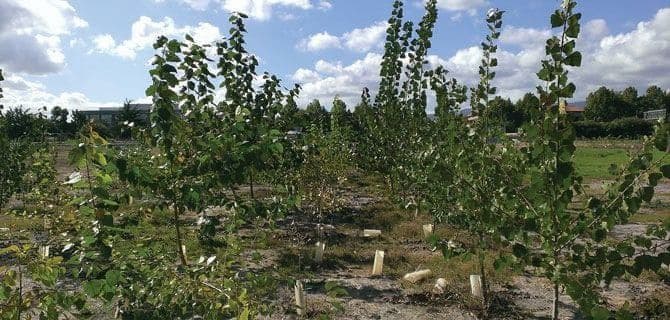Planting poplar trees that harbor a secret weapon—pollutant-busting microbes—could help clean up sites contaminated with the carcinogen trichloroethylene, a new study shows. In the first field trial of this approach at a Superfund hazardous waste site, poplar trees boosted by bacteria within their tissues brought groundwater concentrations of TCE to below the maximum contaminant level […]

Planting poplar trees that harbor a secret weapon—pollutant-busting microbes—could help clean up sites contaminated with the carcinogen trichloroethylene, a new study shows. In the first field trial of this approach at a Superfund hazardous waste site, poplar trees boosted by bacteria within their tissues brought groundwater concentrations of TCE to below the maximum contaminant level for drinking water set by the U.S. Environmental Protection Agency.
TCE is used as a solvent and degreaser in industrial processes, and was recently declared a human carcinogen. It contaminates the soil or water of more than 1,000 Superfund sites around the U.S. Current methods to remove it from groundwater include sorbing it onto activated carbon or driving the pollutant out of water with a stream of air. But these methods are so expensive, says Sharon L. Doty of the University of Washington, that many site managers choose to monitor and isolate polluted areas instead of cleaning them up. Now she and her colleagues have developed a much cheaper approach.
Using plants to soak up pollutants—a method called phytoremediation—can remove a variety of contaminants from soil and groundwater. Introducing symbiotic, pollutant-destroying bacteria to the plants has shown even more promise in lab tests, because carrying the bacteria seems to help plants stay healthier during the process and remove more pollutants. But so far, this probiotic approach has had mixed results in the field, sometimes because the introduced bacteria are outcompeted by naturally present soil microbes.
Several years ago, Doty and her colleagues discovered symbiotic bacteria in a hybrid poplar (Populus deltoides crossed with Populus nigra) that completely break down TCE into chloride ions and carbon dioxide. The researchers found that they could successfully inoculate other poplar trees with the bacteria, a strain of Enterobacter, by soaking tree cuttings in a solution containing the microbe. The microbes colonize the plants after about a week by entering through the roots.
Poplars are especially good phytoremediators because they grow fast, have deep roots, and drink lots of water: Full-grown trees can transpire hundreds of gallons a day. So, in collaboration with several environmental engineering firms, the researchers decided to test poplar trees inoculated with the microbe at a Superfund study area contaminated with TCE in California’s Silicon Valley.
They planted four plots of about 100 poplar trees each, half treated with the microbe, and half with a control solution. Over three years, they tracked the trees’ growth and took core samples to measure TCE and some of its metabolites. At the end of the experiment, they measured groundwater concentrations of TCE upstream and downstream of the trees.
TCE concentrations upstream of the trees were about 300 µg/L, whereas downstream they were below EPA’s drinking water limit of 5 µg/L. Concentrations of other degradation products of TCE were also reduced downstream. The poplars treated with the microbe grew faster than the control trees, with a visible size difference after three years. Inoculated trees also had significantly lower concentrations of TCE. “It’s a really simple way to get rid of an important carcinogen,” Doty says.
Om Parkash Dhankher , an expert in phytoremediation at the University of Massachusetts, Amherst, says it’s exciting that Doty’s team has shown that the method works in the real world. “This is a very cheap and green, clean technology,” he says. Since TCE doesn’t substantially accumulate in the trees, he adds, the wood could possibly be harvested for lumber or other uses. Also, the trees are not genetically modified like some other candidates for phytoremediation, which avoids issues with regulation and public concern, he says.
Doty says the team already has seen great interest in the technology. “Major companies that have purchased land contaminated with TCE are excited to use it to clean up the sites,” she says.
This article is reproduced with permission from C&EN (© American Chemical Society). The article was first published on September 7, 2017.